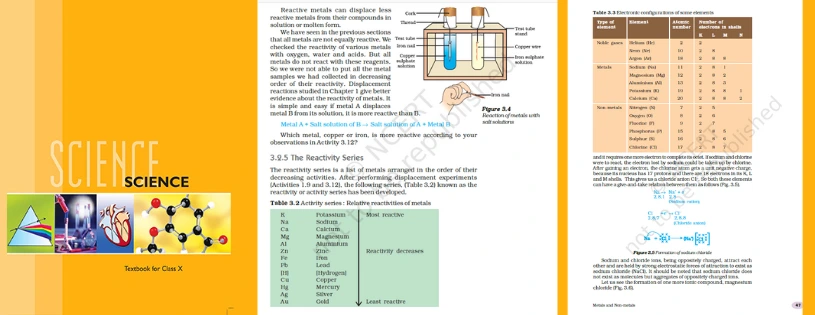CBSE Class 10th Respiration Details & Preparations Downloads
The process by which organisms exchange gasses between their bodily cells and the environment is known as respiration. Every living thing that is alive, including fungus, prokaryotic bacteria, eukaryotic protists, plants, and animals, breathes. Glucose and oxygen combine during regular human breathing to provide energy required for development, maintenance, and movement. The bi-products of respiration that must be expelled are carbon dioxide and water.
All living cells in an organism undergo respiration, which is a metabolic biochemical process in which energy is produced by the intake of oxygen and the release of carbon dioxide from the oxidation of different organic compounds. Adenosine triphosphate, or ATP, is another name for the energy molecule and is the form in which the energy is created.
The different types of respiration
Two distinct respiratory mechanisms have been identified.
1.Breathing in an aerobic manner
2.Respiration without oxygen
Breathing in an aerobic manner: This kind of energy-producing cellular respiration occurs when there is oxygen present. Carbon dioxide (CO2) and water are the byproducts of this kind of respiration, which is seen in both plants and animals.
Examine the process that occurs during aerobic respiration.
Carbon-dioxide 6(CO2) + Water 6(H2O) + Energy (ATP) is the result of glucose (C6H12O6) + oxygen 6(O2).
As can be seen, during this kind of respiration, glucose molecules split in the presence of oxygen, releasing carbon dioxide, water, and energy in the form of ATP as byproducts. ATP molecules are created during this process, which releases a total of 2900 KJ of energy. All kinds of multicellular creatures exhibit it.

Aerobic Respiration in Plants: When oxygen, or O2, reaches plant cells through the stomata on the leaf's epidermis, aerobic respiration in plants begins. Following that, the process of photosynthesis is completed, releasing energy and producing food for the plant's body. Below is the chemical reaction that occurs:
O2 (carbon dioxide) + H2O (water) -> C6H12O6 (glucose) + O2 (oxygen).
Anaerobic Respiration: is an additional form of energy-producing cellular respiration that occurs when oxygen is not present. Without the aid of oxygen, glucose breaks down in this process, producing alcohol, carbon dioxide (CO2), and ATP, or energy. The procedure happens within a cell's cytoplasm. This process's chemical reaction is as follows:
Glucose (C6H12O6) -> Carbon dioxide (CO2) + alcohol (C2H5OH) + energy (ATP)
Aerobic Respiration could be divided into
1. fermentation of lactic acid
2. Fermentation of Alcohol
Fermentation of lactic acid
In this kind of anaerobic fermentation, glucose is divided into two molecules of lactic acid and two molecules of ATP without the presence of oxygen.
One or more of the three process parts may be referred to as respiration. First, the term "respiration" can refer to the process of gas exchange between an organism's cells and the surrounding air or to external respiration. Second, internal respiration—which entails a gas exchange between the blood and bodily cells—may be referred to as respiration. Anaerobic respiration occurs without the need for oxygen, whereas aerobic respiration occurs inside cells.
External Respiration
Breathing externally is one way that one can get oxygen from the surrounding air. Animal creatures carry out the process of external respiration in a variety of ways. While some animals have organs specifically designed for gas exchange or possess a full respiratory system, others rely on diffusion over exterior tissue surfaces to get oxygen. Gases and nutrients are exchanged with the external environment by diffusion across the surface of organisms like nematodes, or roundworms. Fish have gills for gas exchange, whereas insects and spiders have tracheae, which are respiratory organs.
Internal Respiration
The way that oxygen enters body cells is explained by internal respiratory mechanisms. Gasses are transported between the blood and bodily tissues during internal respiration. The thin epithelium of the lung alveoli, or air sacs, allows oxygen from within the lungs to seep into the nearby capillaries that carry blood that has lost oxygen. Concurrently, carbon dioxide diffuses and is discharged in the opposite way, from the blood to the lung alveoli. The circulatory system carries oxygen-rich blood from lung capillaries to bodily tissues and cells.
Cellular Respiration
Cells employ the oxygen they receive from internal respiration for cellular respiration. The biological components that make up food—proteins, carbs, etc.—must be broken down into forms the body can use in order to release the energy contained in it. This is achieved during the digestive process, which breaks down food and absorbs nutrients into the blood. Nutrients are delivered to bodily cells by the circulation of blood throughout the body.

The Different Stages of Respiration
Many metabolic pathways are involved in the process of cellular respiration. Water, carbon dioxide, and a little quantity of ATP are the byproducts of glucose metabolism. Later, in a process called oxidative phosphorylation, which is fueled by electrons traveling via the electron transport chain, more ATP is created.
Anaerobic Respiration in Muscles
All humans typically use aerobic respiration to obtain energy. However, anaerobic respiration can occur in our muscles for a brief period of time when we require more energy. The more physical activity we perform, the more oxygen our muscles require. However, the blood's limited capacity to carry oxygen makes it inadequate.
A portion of our muscles breathe anaerobically when we exert a lot of force. Lactic acid is produced when muscles undergo partial breakdown of glucose through anaerobic respiration. The muscles get overloaded with this lactic acid. Muscle cramps are brought on by a buildup of lactic acid in the muscles.
The Importance of Respiration
In all living things, respiration is the mechanism that supplies and releases energy by transforming dietary energy into chemical forms that may be used by the body for metabolism. Energy is released in a step-by-step, regulated way during this process, ensuring that it is suitable for all cellular functions, including metabolism and cell division. several intermediate products of the citric acid cycle and glycolysis are employed in the production of several chemical molecules involved in cellular metabolism.In a plant, the carbon dioxide exhaled during respiration replenishes the carbon dioxide needed for photosynthesis, and the oxygen exhaled during photosynthesis replenishes the oxygen needed for respiration. As a result, respiration and photosynthesis work in tandem to preserve the natural equilibrium of carbon dioxide and oxygen. Energy is also conserved by respiration. Of the energy released by one glucose molecule, 673 kcal are preserved in 38 ATP molecules.
CBSE Class 10 NCERT Science Topics for a Strong Foundation
| Chapter Name | Life Processes |
| Topic Number | Topic Name |
| 5.1 | Living Being |
| 5.2 | Basic Concept of Nutrition |
| 5.3 | Respiration |
| 5.4 | Transportation |
| 5.5 | Excretion in Plants and Animals |
List of CBSE Class 10 Science Chapter
| Chapter Number | Chapter Name |
| Chapter 1 | Chemical Reactions and Equations |
| Chapter 2 | Acids, Bases and Salts |
| Chapter 3 | Metals and Non-metals |
| Chapter 4 | Carbon and its Compounds |
| Chapter 5 | Life Processes |
| Chapter 6 | Control and Coordination |
| Chapter 7 | How do Organisms Reproduce? |
| Chapter 8 | Heredity |
| Chapter 9 | Light – Reflection and Refraction |
| Chapter 10 | The Human Eye and the Colourful World |
| Chapter 11 | Electricity |
| Chapter 12 | Magnetic Effects of Electric Current |
| Chapter 13 | Our Environment |
List of CBSE Class 10 Mathematics Chapter
| Chapter Number | Chapter Name |
| Chapter 1 | Real Numbers |
| Chapter 2 | Polynomials |
| Chapter 3 | Pair of Linear Equations in Two Variables |
| Chapter 4 | Quadratic Equations |
| Chapter 5 | Arithmetic Progressions |
| Chapter 6 | Triangles |
| Chapter 7 | Coordinate Geometry |
| Chapter 8 | Introduction to Trigonometry |
| Chapter 9 | Some Applications of Trigonometry |
| Chapter 10 | Circles |
| Chapter 11 | Areas Related to Circles |
| Chapter 12 | Surface Areas and Volumes |
| Chapter 13 | Statistics |
| Chapter14 | Probability |
FAQs
Que1.What are the differences between Aerobic and Anaerobic respiration?
Ans. When there is oxygen present, aerobic respiration takes place. This process produces energy more fully and effectively while creating carbon dioxide and water as byproducts. Without oxygen, anaerobic respiration takes place, releasing lactic acid or ethanol as byproducts and yielding less energy.
Que2.What is Respiration in Humans?
Ans. Human respiration is the process by which the body exchanges gases with the environment, mostly carbon dioxide and oxygen. It entails taking in oxygen from the surrounding environment and releasing carbon dioxide, a waste product of metabolism. Inhaling and exhaling cause this exchange to take place in the lungs.
Que3.What are the Key Features of Aerobic Respiration?
Ans. Important aspects of aerobic respiration consist of:
Oxygen requirement: In order to break down glucose and other organic compounds, aerobic respiration needs oxygen.
Production of ATP: The electron transport chain produces a significant quantity of ATP, or adenosine triphosphate, the cell's main source of energy.
Production of carbon dioxide: The procedure yields carbon dioxide as a byproduct.
Efficiency: Compared to other cellular respiration processes, aerobic respiration is the most efficient and produces the most ATP.
Mitochondrial involvement: Enzymes in the mitochondria help break down glucose molecules one after another. This is where it mostly happens.
Que4.What is ATP?
Ans. Cells use adenosine triphosphate, or ATP, as their main source of energy. It's a molecule that functions within living things like a rechargeable battery, storing and releasing energy for cellular operations.
Que5.Why should students choose Testprepkart for their Biology exam preparations?
Ans. Because Testprepkart offers specialized study resources, knowledgeable instructors, and a personalized approach that guarantee efficient learning and improved performance, students should consider them when preparing for their Biology exams.


.webp)

